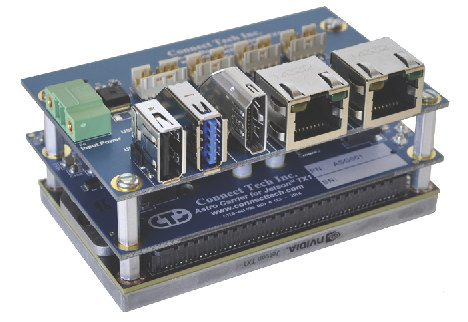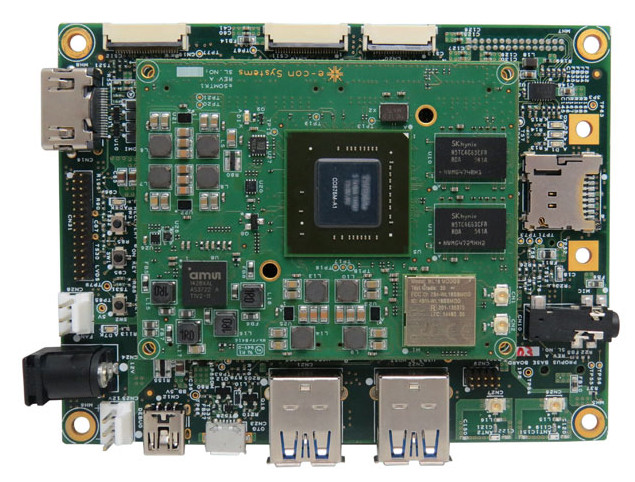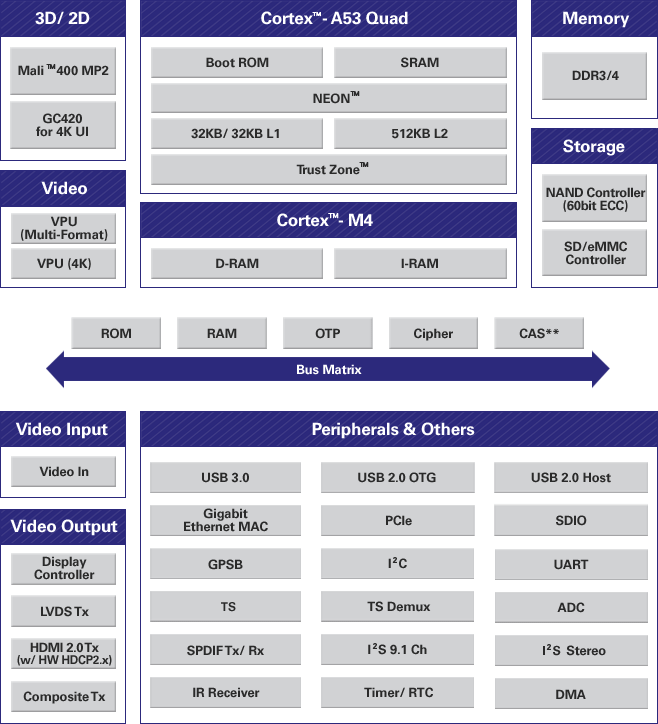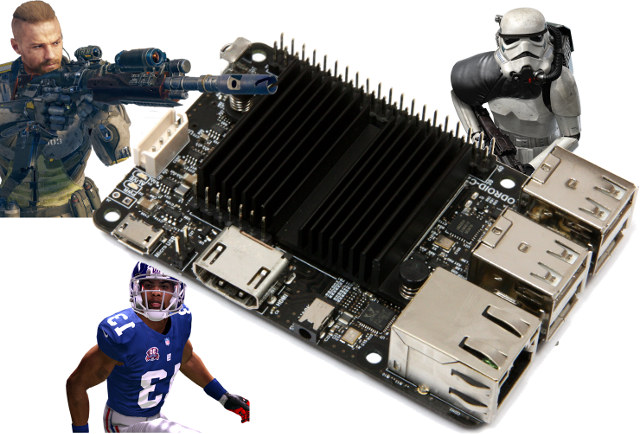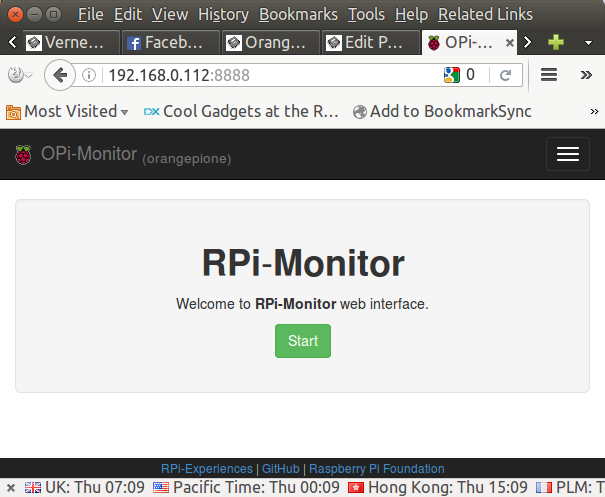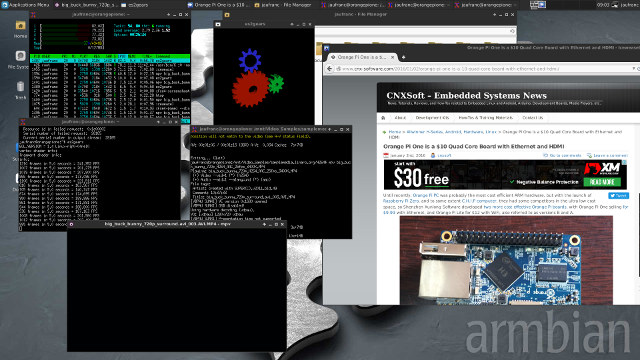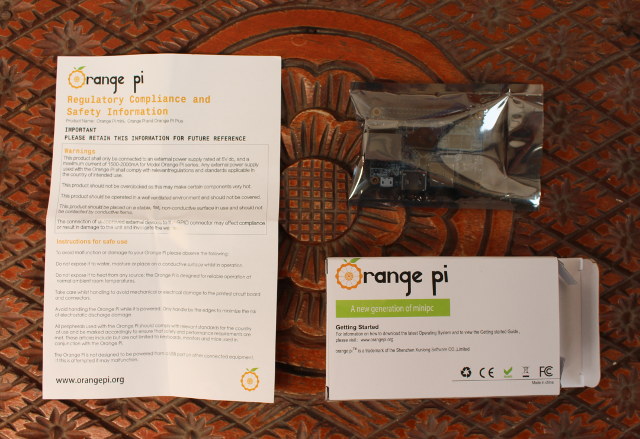Nvidia unveiled Jetson TX1 system-on-module powered by their latest Tegra X1 processor, as well as a carrier board that fits into a mini-ITX case at the end of last year. However, if you need something more compact and lightweight, Connect Tech designed Astro Carrier baseboard for Jetson TX1 module with about the same size, as well as a breakout board with connectors that can be customized as needed. Astro Carrier (ASG001) board specifications: SoM Connector – Samtec “SEARAY” high density board to board connector for Jetson TX1 module Breakout board connectors – 3x 60-pin high density connectors with HDMI, SATA, 2x Gigabit Ethernet (10/100/1000), 1x USB 3.0, 2x USB 2.0, 2x RS-232/RS-485, 2x camera (CSI4), 4x GPIO…… Storage – micro SD slot On-board connectivity – GbE magnetics + Intel 82574 GbE PHY + magnetics Video I/Os 8x u.FL video inputs GMSL (Gigabit Multimedia Serial Link) signaling via 2x MAX9286 deserializer […]
e-Con Systems Propus Nvidia Tegra K1 Development Board Features 3 MIPI-CSI Camera Interfaces
I mostly know e-Con Systems because of their camera modules, but the Indian company has also been manufacturing system-on-modules and development kits, and has just launched Propus development board based on their eSOMTK1 computer-on-module powered by Nvidia Tegra K1 quad core Cortex A15 processor, and including three camera interfaces with two 4-lane and one 1-line MIPI-CSI2 connectors. Propus specifications: Computer-on-module – eSOMTK1-F16G-R2G-WB-IM: SoC – Nvidia Tegra K1 4-plus-1 ARM Cortex-A15 processor @ up to 2.3 GHz with 192-core Kepler GPU. System Memory – 2GB 64-bit DDR3L SDRAM Storage – 16GB eMMC flash Connectivity – 802.11 a/b/g/n and Bluetooth 4.1 module with 2 u.Fl antenna connectors Sensors – 3D digital accelerometer and a 3D digital gyroscope (6 axis) Power Management IC (5V and 12V inputs) SoM connectors – 4x 100-pin board to board connectors Storage – SATA connect, micro SD slot Video Output – 1x HDMI 1.4 Audio – Audio Codec […]
Telechips TCC898x (Alligator) 64-bit ARM SoC is Designed for High-end 4K Set-Top Boxes
Telechips processors were often found in consumer devices such as Android tablets, mini PCs and TV Sticks a few years ago, but it’s been a while since I have seen a devices based on Telechips. So after seeing an automotive SoC from the company, I decided to visit the company website to check if they were still designing processors for the consumer market, and found TCC898x quad core Cortex A53 processor for “Smart Stick, IP-Client and STB with 4K 60fps decoding” with some interesting features. Telechips TCC898x SoC specifications: CPU- Quad core Cortex A53 processor with NEON, TrustZone, 32KB/32KB L1 cache and 512KB L2 cache MCU – Cortex-M4 micro-controller GPU 2D – Vivante GC420 composition processing core for 4K user interfaces 3D – ARM Mali-400MP2 VPU – Multi-format VPU and 4K VPU with HEVC and VP9 support Memory I/F – DDR3/4 Storage I/F – NAND controller (60-bit ECC), SD/eMMC controller […]
Play High-end PC Games on ARM Linux Boards with Moonlight Embedded
Nvidia first showcased PC games streaming to Nvidia Project SHIELD Game Console at CES 2013, and since then Moonlight project has been created to provide an open source implementation compatible with Nvidia Gamestream, and supported on Linux, Mac OS and Windows PC, Android & iOS mobile devices, as well as Samsung VR kits. There’s also an implementation called Moonlight Embedded designed for ARM Linux platforms such as Raspberry Pi,ODROID, Cubox-i boards, and ODROID-C1 and ODROID-C2 boards even got support for H.265 streaming very recently allowing for better quality over H.265 at a given bit rate, and possibly 4K @ 60 Hz gaming on ODROID-C2 board. You’ll need a Windows gaming PC with an Nvidia GTX 600/700/900 series GPU, a wired connecting or a high-end 802.11 router or greater, and Nvidia Geforce Experience (GFE) installed on your PC. H.265 requires an Nvidia 900 series GPU such as Nvidia GTX960. Once this […]
RPi-Monitor is a Web-based Remote Monitoring Tool for ARM Development Boards such as Raspberry Pi and Orange Pi
It can be pretty useful to monitor the CPU load, memory and storage usage, and network traffic of your boards, and they are already graphical tools like System Monitor on Ubuntu providing most of the information, and monit can be used on server, but I’ve recently been introduced to RPi-Monitor utility for Raspberry Pi and Orange Pi boards (patched version), that very easy to install, and provide neat chart of many different variables. Since I’m currently playing with Orange Pi One board running armbian, so that’s the platform I’ve used to run RPi-Monitor (OPi-Monitor). The usage should be exactly the same on Raspberry Pi, but the installation steps are little different. To install RPi-Monitor on Orange Pi One, open a terminal or access the serial console, and you can install and start the service with a single command line:
|
1 2 3 4 5 6 7 8 |
sudo armbianmonitor -r Installing RPi-Monitor. This can take up to 5 minutes. Be patient please .... Now patching RPi-Monitor to deal correctly with H3 Now you're able to enjoy RPi-Monitor at http://192.168.0.112:8888 |
It actually took around 8 minutes on my board, as […]
Accelerated 3D Graphics, Hardware Video Decoding, and Network Performance on Orange Pi One Board (Video)
I’ve just written Getting Started Guide for Orange Pi One, a $10 development board based on Allwinner H3 quad core Cortex A7 processor, where I explain how to install and configure Armbian distribution on the board. As promised, I’ve also tested 3D graphics acceleration, and hardware video decoding, and also included some Ethernet benchmarks. Since ARM Mali-400 GPU found in Allwinner H3 is only capable of OpenGL ES, as in most ARM SoCs, you can test 3D graphics acceleration by using es2gears (and not glxgears as I’ve seen some other do in the past):
|
1 2 3 4 5 6 |
es2gears EGL_VERSION = 1.4 Linux-r3p0-04rel0 vertex shader info: fragment shader info: info: 1463 frames in 5.0 seconds = 292.425 FPS |
The log shows the utility is using Linux-r3p0 Mali driver, and the gears are display at a high frame rate close to 300 fps. If I switch to full screen, the frame rate drops to about 43 fps, which should still be acceptable. CedarX is the infamous closed source and GPL violating media library released […]
Orange Pi One Board Quick Start Guide with Armbian Debian based Linux Distribution
Orange Pi One board is the most cost-effective development board available on the market today, so I decided to purchase one sample on Aliexpress to try out the firmware, which has not always been perfect simply because Shenzhen Xunlong focuses on hardware design and manufacturing, and spends little time on software development to keep costs low, so the latter mostly relies on the community. Recently, armbian has become popular operating systems for Linux ARM platform in recent months, so I’ve decided to write a getting started guide for Orange Pi One using a Debian Desktop image released by armbian community. Orange Pi One Unboxing But let’s start by checking out what I received. The Orange Pi One board is kept in an anti-static bag, and comes with a Regulatory Compliance and Safety Information sheet, but no guide, as instead the company simply asks users to visit www.orangepi.org to access information […]
Linux 4.5 Released – Main Changes, ARM and MIPS Architectures
Linus Torvalds released Linux Kernel 4.5 on Sunday: So this is later on a Sunday than my usual schedule, because I just couldn’t make up my mind whether I should do another rc8 or not, and kept just waffling about it. In the end, I obviously decided not to,but it could have gone either way. We did have one nasty regression that got fixed yesterday, and the networking pull early in the week was larger than I would have wished for. But the block layer should be all good now, and David went through all his networking commits an extra time just to make me feel comfy about it, so in the end I didn’t see any point to making the release cycle any longer than usual. And on the whole, everything here is pretty small. The diffstat looks a bit larger for an xfs fix, because that fix has […]


